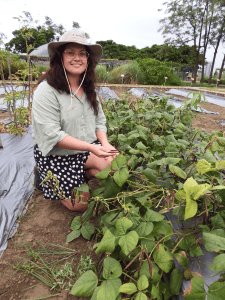I always wanted to work in agricultural development. I have family from Myanmar, but in Australia this is a real niche field, and it wasn’t easy to find ways to use science to help farmers. But thanks to the Crawford Fund, I was given a scholarship to go to WorldVeg in Taiwan, and what an experience it was!

And this came at just the right time in my life. I was wondering where I could apply the skills that I am learning, and so this opportunity to spend time in an international research center was amazing. The scientists were so welcoming. I could feel that they wanted to work with me, and that I wasn’t ‘just another intern’. I saw how they work together, share, learn from each other – much better than scientists do at universities! And yes, this is the sort of place I could work. People from so many diverse cultures, each bringing their own perspectives. Wonderful!
I’m in the last year of my PhD at the Centre for Crop Science at the University of Queensland, Brisbane, on the use of drones for phenotyping mungbean. And here at WorldVeg, you have Phenospex, which we don’t have. And I learned to use a new methodology that looks at data not just over the field, but also continuously over time and not just from specific points in time. This opened my eyes, and will help a lot as I finish my PhD. And I see clearly now how this can really help to accelerate breeding and crop improvement, especially with such under-resourced orphan crops like mungbean. The potential benefits are obvious, and surely this offers a lot of bangs per buck. I also see how this can be applied to other crops too, and not just mungbean.
What is ‘phenotyping’ and why is it important
Overcoming the challenges of food insecurity is a pressing global need, and developing improved crops adapted to changing climatic and biotic stresses will be key. To do this more effectively, plant breeders must better understand the differences in the physical expression of plant genes. This is done through ‘phenotyping’, the process of determining, analyzing and predicting an organism’s phenotype, i.e. the observable characteristics produced by the interaction of the genotype and the environment.

I was also fortunate to be here for PhenoVeg 2023, an international conference specifically on phenotyping. More than a hundred specialists came from around the world, and talked about their own experiences in this field.
And yes, I would certainly recommend an internship at WorldVeg, and will tell people at my university to suggest it. It was great too, to become friends with the other five interns from India and Nigeria, and the first time outside their home country for some of them.
I want to thank all the scientists for their support, and the other interns for their friendship. But special thanks to Ya-ping Lin the omics breeder for sharing so much of her deep knowledge, and Roland Schafleitner my supervisor. And of course, to the Crawford Fund and the WorldVeg Center for giving me this opportunity!
Contact: Shanice Van Haeften, QAAFI Centre for Crop Science; s.vanhaeften@uq.edu.au or The Crawford Fund about student scholarship opportunities.
This blog article What a great internship, a stepping stone in my career was first published by The World Vegetable Centre on 27 October 2023.
